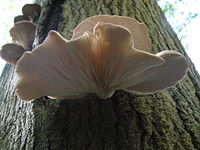
Photo from wikipedia
Arbuscular mycorrhizal fungi (AMF) are known to alleviate the undesirable effects of biotic and abiotic stresses on plants. The objective of this study was to assess the effect of AMF… Click to show full abstract
Arbuscular mycorrhizal fungi (AMF) are known to alleviate the undesirable effects of biotic and abiotic stresses on plants. The objective of this study was to assess the effect of AMF symbiosis on plant growth, physiology, and nutrients accumulation in leaves and roots of Ailanthus altissima (Mill.) Swingle under Cd and saline conditions. The pot experiment was carried out in factorial based on randomized complete block design (RCBD) with three replications. The treatments included salinity at three levels (non-saline water, 4 ds/m, and 8 ds/m), inoculation with AMF at two levels (uninoculation and Glomus mosseae inoculation) and cadmium (Cd) pollution at three levels (unpolluted soil, 15 mg Cd/kg soil, and 30 mg Cd/kg soil). The results revealed salinity and Cd pollution decreased plant height shoot and root biomass, but AMF increased them. The highest plant height, shoot and root biomass were observed at unpolluted and non-saline water. In contrast, the lowest plant growth was in uninoculated treatments with high salinity and Cd levels. Salinity increased proline content, CAT and SOD activities. Cd pollution did not change the proline concentration in the plants. The highest proline concentration and antioxidant enzyme (SOD and CAT) activities were observed in uninoculated plants with simultaneous application of high Cd and salt levels. Na+ accumulation in roots and leaves increased with salinity, but AMF decreased it. K+ content in leaves and roots decreased with Cd pollution and salinity and AMF increased it. Salinity and Cd pollution significantly accumulated high Cd in roots and leaves. Our work will widely improve the current knowledge of salinity and Cd tolerance mechanisms in tree species.
Journal Title: Russian Journal of Plant Physiology
Year Published: 2021
Link to full text (if available)
Share on Social Media: Sign Up to like & get
recommendations!